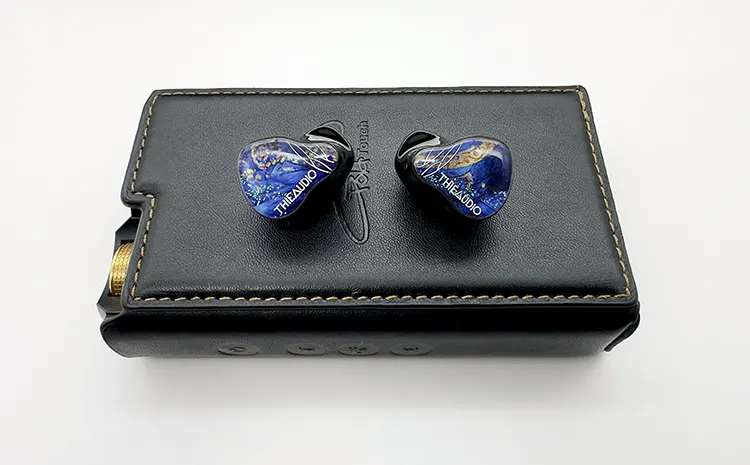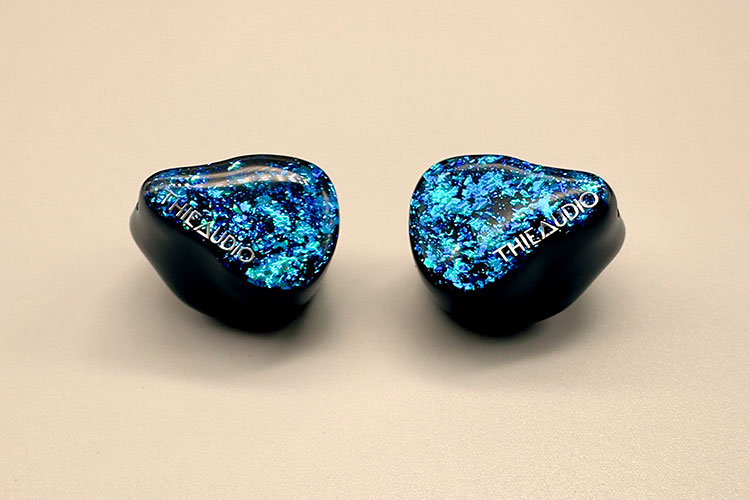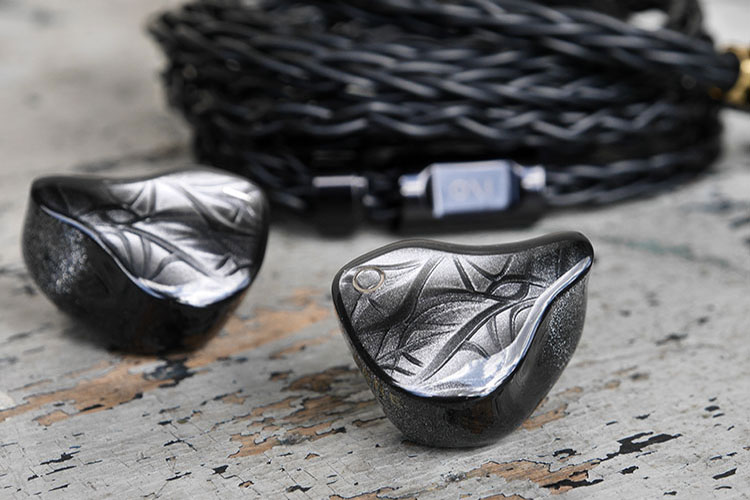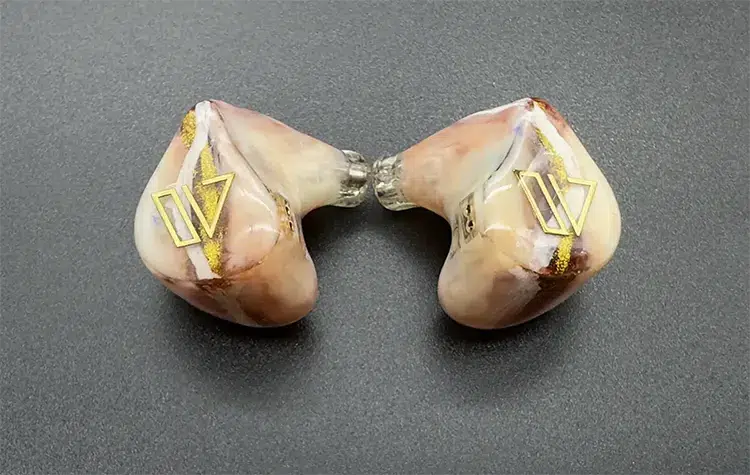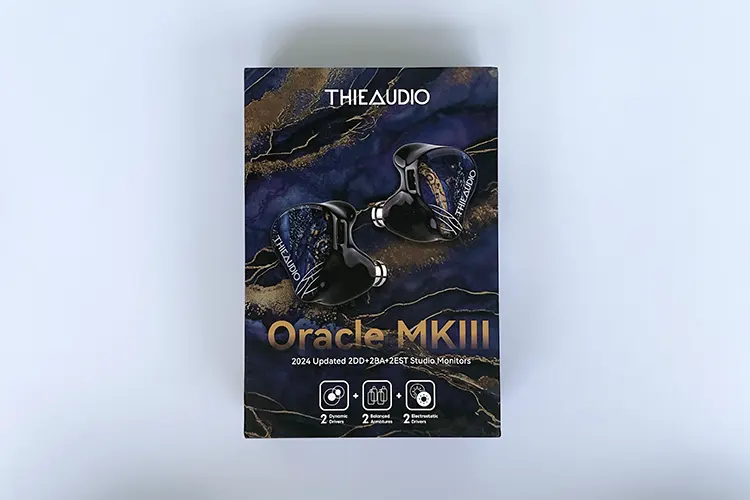Synergy
Efficiency & Sensitivity
THIEAUDIO Oracle MKIII has an impedance of 13Ω @ 1kHz and a sensitivity rating of 99 dB/Vrms. The IEM can be comfortably driven by sources with fewer power specifications, such as dongles and smartphones.
However, the EST drivers allow the IEM to benefit from a bit of extra power. The dynamics noticeably improve when paired with a higher-quality source.
When connected to sources with strong power capabilities, like the Lotoo Paw Gold Touch or Earmen Angel, the sound becomes more spacious and well-defined, with a richer presentation.
With additional power, the IEM scales quite well, and it does not get harsh or peaky, showcasing impressive dynamics.
Source Pairings
Among the sources I’ve tried with the Oracle MKIII, the most enjoyable pairing has to be with the LPGT. The DAP delivers just the right amount of power and warmth, resulting in a sound that’s lush and rich without being overwhelming.
The bass has a satisfying body, and the texture and layering stand out compared to other sources. The treble is airy and well-extended. There is a decent sense of depth to the soundstage on the LPGT.
On the Questyle CMA18P, which features an AKM 4493 DAC chipset, the Oracle MKIII takes on a more neutral and slightly treble-focused profile. The CMA18P’s power output complements the Oracle MKIII, maintaining a strong bass performance while adding a crisp edge to the treble.
This treble response adds a bit of spice to the mix, but it stays clear of becoming fatiguing. Those who may prefer a bit of zing in the upper region will find this pairing quite good.
With Earmen Angel, a quite powerful source, the Oracle MKIII has a decent pairing. It loses a few bits of the bass goodness while adding a nice touch of neutrality to the midrange. The treble region is quite smooth on this pairing with a nice spaciousness in the soundstage.
Select Comparisons
THIEAUDIO Hype 4
Technical
The THIEAUDIO Hype 4 is a hybrid IEM that features dual dynamic drivers and four Sonion balanced armature drivers. It incorporates the IMPACT2 technology common in the Hype series IEMs, Monarch MKIII, and Oracle MKIII.
Hype 4 has an impedance of 17Ω @ 1kHz and a sensitivity rating of 105 dB/Vrms. The IEM can be easily driven by sources with less power, such as dongles and smartphones.
While the Hype 4 doesn’t require a lot of power to sound adequate, the Oracle MKIII benefits from additional power owing to a different driver configuration and the presence of EST drivers.
On my LPGT, the Oracle takes nearly 40+ volume levels, while Hype 4 remains at 35.
Design
Maintaining a consistent design language across their IEMs, Hype 4 comes with black shells and artistic, shiny faceplates. and additional white and blue options.
The white variant has a pearly body, while the black and white options differ mainly in their faceplate patterns, and their shells are black. The Oracle MKIII has a single variant.
Both IEMs feature similar resin shells, with the Hype 4 having a slightly smaller shell but the difference is minimal.
They both provide a comparable level of comfort; both the IEMs have a similar design, so fit-wise, I find them similarly comfortable.
The Oracle MKIII and Hype 4 use a 0.78mm 2-pin connector, but the Oracle MKIII offers a modular cable with interchangeable terminations, including 4.4mm, 3.5mm, and 2.5mm options. The cables on both IEMs have a similar look and feel.
As for accessories, the two IEMs are nearly identical, arriving in boxes of the same dimensions. The only notable difference is the modular cable included with the Oracle MKIII, otherwise, everything from ear tips to the carry case is the same.
Performance
The primary distinction between these two IEMs lies in the driver configuration, specifically, the additional EST drivers in the Oracle MKIII, which make the treble presentation noticeably more detailed and airier.
Both IEMs feature dual dynamic drivers and the same IMPACT2 technology, so the bass impact is similarly robust. However, the Oracle MKIII offers an enhanced mid-bass, leading to a punchier and more textured bass overall.
The Oracle’s midrange stands out with a fuller and more engaging presentation, offering a better level of body in vocals.
Female vocals on the Hype 4 might feel a bit thinner in comparison, whereas the Oracle MKIII delivers a denser, more natural midrange, adding an emotional depth to the sound. The upper midrange on both IEMs is well-controlled, avoiding sharpness or fatigue.
While the treble on the Hype 4 is already impressive, the Oracle MKIII takes it a step further with superior detail retrieval and a smoother, more extended treble.
The Oracle’s treble is airier, revealing finer details that might be less pronounced on the Hype 4. However, this could be a matter of preference, as the Oracle’s treble can sometimes feel a bit exaggerated, whereas the Hype 4’s treble is more restrained.
Both IEMs offer a similar soundstage width, but the Oracle MKIII excels with greater height and depth, contributing to a more spacious and refined listening experience. The Oracle MKIII also has better resolution and micro-detail retrieval, making the sound more polished overall.
I/O AUDIO VOLARE
Technical
The VOLARE is a tri-brid universal IEM with a single dynamic, four balanced armatures, and four electrostatic drivers inside.
The 8mm dynamic driver diaphragm uses a birch wood dome with a silicone rubber surround. VOLARE has a four-way electronic crossover along with a three-way physical crossover.
The VOLARE has a sensitivity of 121 dB/Vrms @ 1 kHz and an impedance of 4.8Ω +/- 10% @ 1 kHz. In terms of driveability, I would rate them quite similar, as both of them can scale a bit and benefit from some good, powerful source. On my LPGT, both the IEMs take a volume level of more than 40.
Design
The I/O VOLARE features resin shells with a sophisticated black and silver color scheme, adorned with tiny glitters that give it a shiny, eye-catching appearance.
The faceplate boasts a bold design with organic veins crisscrossing deep within the thick resin, adding depth and intricacy. Both IEMs are well-crafted in terms of design and appearance, though I prefer the more colorful faceplate of the Oracle MKIII.
When it comes to presentation and accessories, the VOLARE offers a more premium experience. It arrives in a drawer-style box with three separate layers, each containing different sets of accessories. The inclusion of as many as 15 pairs of ear tips showcases the brand’s attention to detail and humble offering.
The VOLARE’s cable is an 8-strand, oxygen-free, copper, silver-plated unit with a swappable plug system that includes a 3.5mm single-ended plug as well as 2.5mm and 4.4mm balanced options, much like the Oracle MKIII.
However, I find the VOLARE’s cable to have a sturdier build, especially with the termination jacks, which are quite robust and well-crafted.
Performance
When comparing both IEMs, it becomes clear that they share a close profile, with a few key differences. Both offer a satisfying dose of bass, a nearly neutral midrange tonality, and an airy, sparkly upper-frequency range.
The VOLARE provides more sub-bass body and depth, while the Oracle MKIII excels in mid-bass punch and impact, giving the bass a more dynamic presence overall.
Both IEMs maintain good texture and layering in the bass, but the Oracle MKIII’s stronger mid-bass makes its bass performance a bit more satisfying.
I found that bith IEMs stay true to the music with their near-neutral midrange presentation with a touch of warmth. However, the Oracle MKIII leans slightly less warm and has less thickness in the lower midrange.
The VOLARE, on the other hand, has a richer midrange with denser vocals, offering a fuller sound. The upper midrange on the Oracle MKIII is sharper, occasionally veering into spicier territory. The VOLARE keeps things smoother and less sharp in this area, adding richness to the midrange.
On the VOLARE, you’ll experience a well-extended, quick, and sparkly upper range that brings plenty of energy without fatiguing your ears.
The Oracle MKIII’s treble has all these but with an extra sharpness that can become fatiguing unless you carefully pair it with the right ear tip and source to tame it down. VOLARE’s treble is smoother and overall, more enjoyable.
The soundstage on each offer’s comparable width and depth, with a satisfying sense of spaciousness though VOLARE has better depth on the soundstage.
The resolution is nearly on par, though the VOLARE has a slight edge in this area. Imaging and layering are also closely matched, with both delivering a similar level of precision.
Alpha Omega Ra
Technical
The Alpha Omega Ra universal IEM has a tribrid multi-driver configuration. There are a total of 7 drivers with a 4-way passive crossover. This includes a 10mm dynamic driver, 4 Sonion BA drivers, and 2 Sonion EST drivers.
The beryllium-plated 10mm dynamic driver takes care of the lower frequencies, dual BA drivers for the lower mids, and a second dual driver BA set for the upper mids frequencies. The final 2 EST drivers cover the higher treble frequencies.
The Alpha Omega Ra has an impedance rating of 28Ω @1kHz with an SPL of 105 dB/Vrms. While both the IEMs benefit from some good sources, Ra takes a bit of extra juice to shine.
Design
The Alpha Omega Ra features resin-built shells that are robust and durable, with each one hand-painted to resemble marbles from a distance.
The shell design on Ra is inspired by CIEMs and is larger than the Oracle’s shell. While both have a good fit, the smaller shells on the Oracle MKIII are more comfortable.
The shells of the Alpha Omega Ra can be customized with different colors and paint designs. Ra’s wider nozzle is a bit larger than Oracle’s which can make the fit challenging for some.
Ra connects with a 0.78mm 2-pin connector and comes with a 4-core gold-plated 26AWG Litz copper cable.
Performance
The Ra has a V-shaped signature, while the Oracle MKIII leans more toward a W-shaped. On Ra, there is a bass emphasis and tamed treble, while Oracle MKIII takes a more balanced approach in its tuning.
With its single dynamic driver, the Ra offers more quantity, impact, and punch than the Oracle’s dual dynamic driver setup.
The Ra’s sub-bass is deeper and fuller, giving it a richer low-end that borders on basshead territory. While the Oracle MKIII provides a respectable level of mid-bass, the Ra’s bass is more hard-hitting, adding an extra layer of fun to its sound signature.
Both IEMs share a lush and rich midrange tonality. However, the Ra’s lower midrange has a bit more body, making the Oracle MKIII’s midrange appear slightly leaner.
The Oracle MKIII shines with its cleaner and crisper midrange presentation, bringing out details with sharper precision and better extension into the upper midrange.
The Ra takes a more subdued approach to treble, sounding smoother and less energetic. It lacks the airiness and sparkle that the Oracle MKIII offers. The Oracle’s treble is more extended and detailed, giving it an open and spacious feel.
While the Ra opts for a tamer, non-fatiguing treble that still retains a decent level of detail, the Oracle MKIII’s upper-frequency prowess makes it a clear winner.
The Ra has a more intimate soundstage, with a slightly better depth in the front-to-back dimension. However, the Oracle MKIII offers a wider soundstage and better resolution, particularly due to its superior upper-frequency detailing.
This allows the Oracle to paint a clearer, more detailed picture, bringing micro-details to the forefront.
My Verdict
If you ask me whether I like the sound of the THIEAUDIO Oracle MKIII, my answer would be a resounding yes. This tuning is a win for anyone who appreciates a neutral and clean profile with just a touch of warmth.
The balance in the tuning is truly commendable despite the extra focus on the bass and treble, neither overwhelms the other frequency regions. While I appreciate most aspects of the tuning, the treble could benefit from being a bit smoother and less pronounced.
Initially, I thought the Oracle MKIII might not offer much more than the Hype 4, which already excels at what it does. But I was wrong.
The Oracle MKIII stands out as a solid upgrade, offering a more refined and detailed sound. Its technical prowess is impressive, confidently holding its own against other IEMs in a similar price range.
For me, the Oracle MKIII is an easy recommendation that’s sure to impress its listeners.
THIEAUDIO Oracle MKIII Specifications
- Driver Configurations: 2 Dynamic Drivers + 2 Balanced Armatures + 2 EST Drivers
- Frequency Response: 20 Hz – 44 kHz
- Impedance: 13Ω±1Ω
- Sensitivity: 99 dB (± 1 dB) @1kHz
- Crossover: four-way
- Cable: silver-plated OCC cable, detachable 0.78mm 2Pin
- Modular Termination with 2.5mm, 3.5mm, and 4.4mm interchangeable plugs


